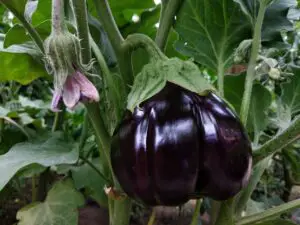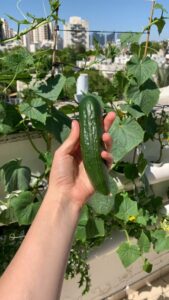write an introduction and tell why a beginner hydroponic gardener would want to grow eggplant.
Eggplants are versatile vegetables that can be used in a variety of dishes, making them a popular choice among cooks and home gardeners.
Hydroponic eggplants tend to produce more bountiful harvests compared to traditional soil-based growing methods, and they are also less prone to common pests and diseases.
Whether you are new to hydroponics or a seasoned gardener, growing hydroponic eggplant using the Kratky method can be a great way to produce bountiful crops of your favorite vegetable. This simple and effective method requires minimal time and effort while allowing you to enjoy the many benefits of hydroponic gardening.
Introduction to hydroponics and Kratky
What is hydroponics?
Hydroponics is a method of growing plants without soil, using liquid nutrients in a hydroponic system to provide the plants with everything they need for healthy growth. There are many different hydroponic systems and techniques, but one popular approach is known as the Kratky method, which is a simple and effective way to grow hydroponic eggplants.
There are several key things that you should know when using the Kratky method to grow hydroponic eggplants, including how to set up your hydroponic system, what nutrients and lighting are required for successful growth, and how to care for your plants on an ongoing basis. With the right knowledge and preparation, you can grow hydroponic eggplants that are healthy and flavorful using this easy and efficient method. So if you are looking to start growing hydroponic eggplants, be sure to keep these tips in mind to help ensure your success.
What is the Kratky method?
The Kratky method is a hydroponic growing technique that involves setting up a hydroponic system and then simply leaving it alone, without adding any additional nutrients or other inputs.
This approach uses the natural transpiration process of the plants to move water and nutrients through the hydroponic system, resulting in healthy growth with minimal effort on your part.
Unlike many other hydroponic systems, Kratky is very simple to set up, isn’t costly, and doesn’t require electricity. All you need for creating a Kratky system of your own is a container (from a mason jar to a 5-gallon bucket), a net cup, and a growing medium like clay pebbles or rock wool.
Why choose Kratky for your eggplants?
You can choose any method for hydroponic eggplants. I chose Krakty because it’s particularly well-suited to eggplant cultivation, as it allows you to easily maintain and monitor your hydroponic system with very little hustle.
Eggplants are a relatively low-maintenance crop, making them an ideal choice for hydroponic growing. Additionally, hydroponic eggplants tend to produce larger and more flavorful fruits compared to those grown in soil.
How to grow a Kratky method eggplant?
- Put your eggplant in the net cup.
- If the plant is small, put it in grow medium like coconut coir or rock wool. Add some clay pebbles to prevent them from moving.
- Fill your container with water
- Add nutrients to the water
- The water should touch the tip of the roots, or the grow medium. Too much water and the roots will rot.
- Put the net cup back in the water container
- Cover the rest of the container. You don’t want water to vaporize and don’t want anything to get into your water.
- Wait and let mother nature work her magic.
Hydroponic eggplant maintenance:
Season: eggplants need warm climate. If you don’t monitor the temperature, plant them at the very end of winter or beginning of spring.
Growth: 2-6 weeks to harvest
Light: Eggplants need 6 hours of direct sun – or more.
pH level in water should be 5.5 to 6
PPM between 1750-2400
Water: in Kratky, you shouldn’t add water to the container once the plant is inside. As a beginner, you may need to do so because you ran out of water too soon.
Container: leafy greens can grow in small containers like mason jars. Fruits and vegetables should have larger containers. They require more room for their larger root system. A larger root system is required to produce fruit. If I wish to harvest eggplants, I would choose a container of at least 2 gallons.
Can eggplant be grown indoors?
Yes, but if you want to get fruit, it needs enough warmth and light. Otherwise, you will have only leaves. You can give it the light it needs using fluorescent light or have a grow tent. Hydroponic eggplant cultivation involves maintaining proper hydration and nutrient status, so it’s important to monitor your plants carefully and adjust the water and nutrients if needed. You may also need to provide additional heat if your hydroponic system is not kept indoors.
What should you expect from your hydroponic eggplant?
Growing a hydroponic eggplant, you should know these things:
Eggplant growth stages
There are three main phases of hydroponic eggplant growth: seedling, vegetative, and fruiting. During the seedling stage, your plant will develop its roots and begin to establish itself in the hydroponic system. The vegetative phase is when the plant grows most rapidly, producing new leaves and shoots and strengthening its root system. Finally, the fruiting stage is when eggplants begin to develop flowers and fruit.
Hydroponic eggplant nutrient
In hydroponic eggplant cultivation, proper hydration and nutrient status are key to optimal growth. Generally, hydroponic eggplants need a water solution with pH between 5.5 and 6 and PPM levels of 1750-2400.
What is the expected hydroponic eggplant yield?
The hydroponic eggplant yield will vary depending on the growing conditions and variety, but in general hydroponic eggplants produce larger and more flavorful fruits than those grown in soil.
Additionally, hydroponic cultivation is often more efficient when it comes to yield per square meter, allowing you to get high yields from a relatively small amount of space. Some hydroponic eggplant varieties produce fruit within 2-6 weeks, while others may take several months to reach maturity.
They typically produce large, flavorful fruits that make a delicious addition to salads or stir-fries.
How long does it take to grow eggplant hydroponically?
With the Kratky hydroponic method, you can expect to see eggplant growth within 2-6 weeks. This will vary depending on the hydroponic system and growing conditions (climate, nutrients, container size), as well as the variety of eggplant that you are growing.
Conclusion: can you grow eggplant hydroponically?
Yes, hydroponic eggplant cultivation is a great way to produce high-quality and flavorful fruits even if you don’t have access to the ideal outdoor growing conditions. I recommend the Kratky method because it’s the easiest way to get started.
Whether you want to grow hydroponic eggplant indoors or outdoors, there are many different hydroponic systems and methods that you can use to successfully cultivate these nutrient-rich fruits. With proper care and attention, you can expect to see healthy hydroponic eggplant growth within 2-6 weeks. So if you’re looking for a fast, easy way to grow delicious eggplants hydroponically, hydroponics may be the perfect choice for you!
Yes, hydroponic eggplant cultivation is a great way to produce high-quality and flavorful fruits. This method of hydroponics involves maintaining proper hydration and nutrient status in order to promote healthy growth and achieve optimal yields.
There are many different hydroponic systems and methods available for growing eggplants, but the Kratky method is one of the simplest and most popular options. This method requires minimal setup and maintenance, making it a great choice for beginners who want to try hydroponics. Additionally, eggplants grown using the Kratky method often produce larger and more flavorful fruits than their soil-grown counterparts. For these reasons, many growers choose to grow their eggplants hydroponically using the Kratky method.
You can grow your eggplant in water with the Kratky hydroponic method. Kratky method is the easiest hydroponic method, with the least work to do.
You can grow your eggplant in water with the Kratky hydroponic method. Kratky method is the easiest hydroponic method, with the least work to do.





